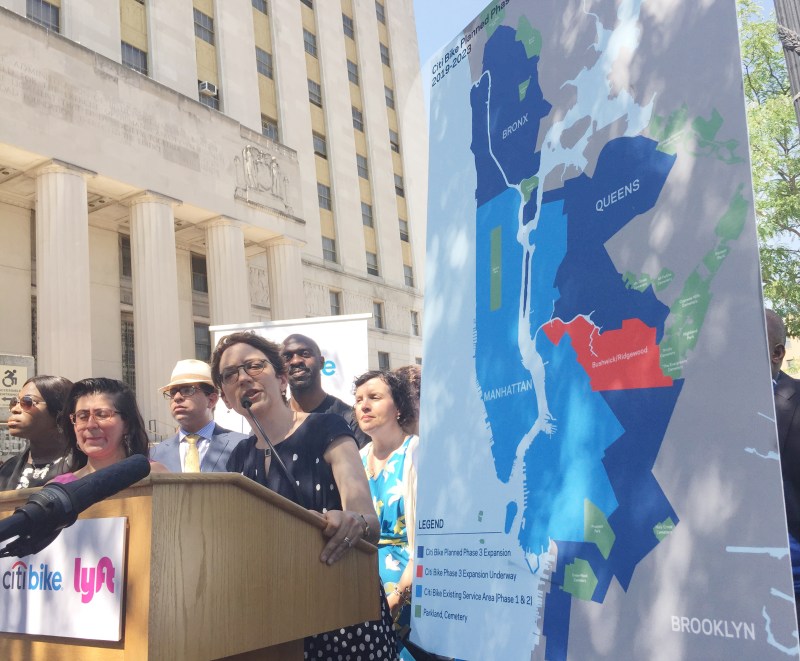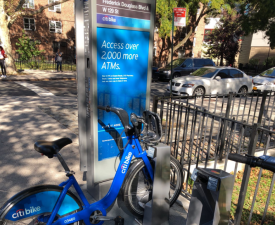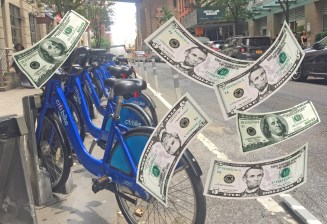BREAKING: Citi Bike Expansion Revealed — And It’s a Slow Rollout

Citi Bike will finally begin its long-awaited expansion into the Bronx and upper Manhattan later this year, but a broader, deeper expansion into Brooklyn and long-suffering Queens will take another four years.
City — and “Citi” — officials will gather in the Bronx on Tuesday morning to herald the expansion of the Citi Bike zone, but Streetsblog obtained a truncated preview that reveals a few choice details from the Lyft-owned company:
- New stations will start showing up quickly in Ridgewood, Queens as part of an existing expansion of Citi Bike in the so-called L-train corridor of Williamsburg and Bushwick.
- Next, Citi Bike will expand into the South Bronx — how “south” remains unclear — and Upper Manhattan. Currently, the Citi Bike zone only extends as far north as 130th Street, leaving City College, Hamilton Heights and Washington Heights cut off. A preliminary press release said that new stations in the South Bronx and the remainder of Manhattan will be installed starting next year — after consultations with community boards.
- The final phase of the expansion — from 2020 through 2023 — will include more neighborhoods, including:
- In the Bronx: Mott Haven, Melrose, Port Morris, Highbridge, Claremont, Morrisania, Longwood, Concourse and Mt. Eden.
- In Queens: Sunnyside, Maspeth, Elmhurst, Jackson Heights and Corona.
- In Brooklyn: Bedford-Stuyvesant, Brownsville, Crown Heights, Prospect Lefferts Gardens, East Flatbush, Sunset Park, the area south of Park Slope, Windsor Terrace and Kensington.

The map of the expansion zone (left) follows a promise that Citi Bike officials made last year to double the bike share system’s footprint, and triple its fleet size to 40,000 bikes, by 2023, so Tuesday’s announcement appears to be on schedule.
Staten Island will not get Citi Bike. Earlier this year, the city announced it would expand its existing pilot program of dockless bike share provided by Lime and the Uber-owned Jump to the entire island.
Tuesday’s announcement will be greeted with relief across a wide swath of the city that has been denied Citi Bike, which began in 2013, and has been slow to expand beyond Manhattan and gentrified stretches of Brooklyn. The Citi Bike zone reflected a decision — some call it the original sin of Citi Bike — by the Bloomberg administration to keep public money out of the privately run bike share system, making it the only form of mass public transit that does not get public subsidies.
That strategy was continued by the de Blasio administration, which has heavily invested in a ferry system that serves far fewer users than Citi Bike — with its 17.6 million rides last year from its 150,000 annual members and many thousands of tourists.
As a result, some of the neighborhoods on the list that will be released on Tuesday will have waited 10 years from the beginning of the bike share system to become part of the Citi Bike zone. And other neighborhoods, such as Forest Hills and Rego Park in Queens, and Bay Ridge in Brooklyn, for example, won’t get Citi Bike until the next mayor is preparing for his or her re-election runs.
Terrible news @CitiBikeNYC just way too slow. Queens has already waited since 2013 and we finally got a tiny sliver that’s useless for 98% of the borough and now you are saying we have to wait for the final phase – three more years. Very disappointed. What’s the issue?
— JimRockaway (@JimRockaway) July 16, 2019
“We clearly aren’t happy that Queens Boulevard has this amazing bike lane, but Rego Park and Forest Hills aren’t getting any bike share,” said one Queens cycling activist. “That’s insane.”
Council Member Justin Brannan of Bay Ridge will no doubt be upset as he reads this. Earlier on Monday, he tweeted his disappointment that Citi Bike continues to serve “areas that already have an embarrassment of riches when it comes to transit options.” He suggested that the city strip Lyft of its monopoly zone to allow competition from other bike share systems, such as Lime, Jump and others.
Citi Bike mainly serves areas that already have an embarrassment of riches when it comes to transit options.
Gotta stop prioritizing this questionable contract and start allowing real competition from other operators.
@AdrienneEAdams @RitchieTorres https://t.co/BQ6tZ7q9xz
— Justin Brannan (@JustinBrannan) July 15, 2019
But Citi Bike supporters — including city officials — have said that a single contiguous system is the only way for Citi Bike to make a profit and keep expanding. Last week, former Bloomberg official Jon Orcutt told Streetsblog that one expanding map is the way to go. “Building little pods of isolated bike share is a recipe for failure,” he said.
That comment came as Citi Bike was under fire last week from advocates for two groups mostly cut out of Citi Bike: the poor and those who live in transit deserts. New York Communities for Change — formerly ACORN — argued that the public bike share system needed to expand into some of the very neighborhoods that will be announced on Tuesday.
That said, the group was also pushing for a wider expansion that would have left some gaps in coverage.
https://twitter.com/BayRidgeDrivers/status/1150964189013454854




